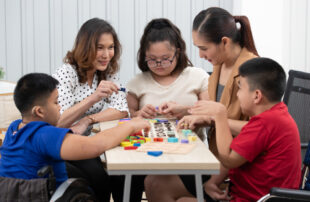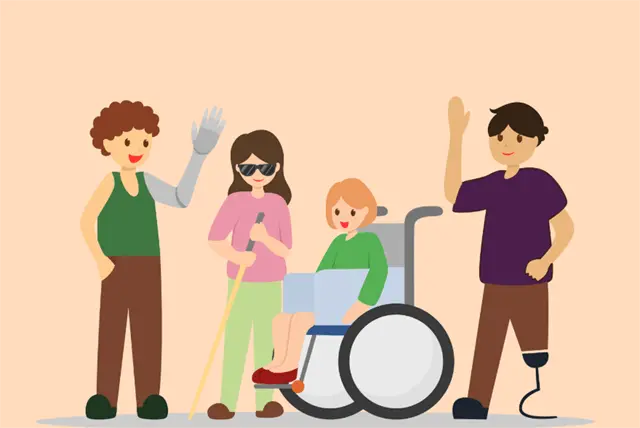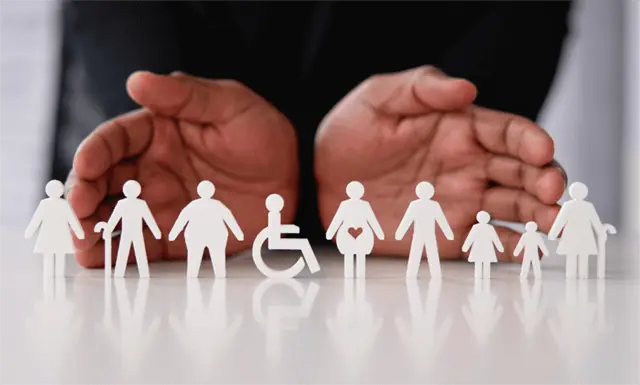Understanding the wide range of disabilities, from physical impairments such as those caused by muscular dystrophy to sensory disabilities like deafness, is essential for fostering a more inclusive society.
In this article, we’ll discuss the various types of disabilities, exploring how each impacts individuals’ lives and why awareness and inclusion are crucial.
Understanding Visible and Invisible Disabilities
Visible Disabilities
Visible disabilities are those that have physical manifestations, making them noticeable to others. These include conditions like paralysis, where an individual may use a wheelchair, or amputations, where a person may have a missing limb or use a prosthetic. Sensory disabilities, such as blindness or deafness, often involve the use of assistive devices like canes, guide dogs, hearing aids, or cochlear implants, which are apparent to observers.
Visible disabilities typically prompt immediate recognition and awareness, leading to more straightforward accommodations in public spaces. For example, ramps for wheelchair users, Braille on signage for the visually impaired, and sign language interpreters for the deaf are common adaptations. However, while visible, these disabilities can still lead to significant challenges, including social stigma and accessibility barriers.
Invisible Disabilities
Invisible disabilities, on the other hand, are those that are not immediately apparent to others. These can include a wide range of conditions, such as mental health disorders (like depression or anxiety), neurological disorders (such as ADHD or autism), chronic illnesses (like fibromyalgia or Crohn’s disease), and learning disabilities (such as dyslexia or dyscalculia).
Because invisible disabilities do not have outward physical signs, they can often be misunderstood or overlooked. People with invisible disabilities may face scepticism about the legitimacy of their condition, leading to a lack of support or accommodations. For instance, someone with chronic pain may not be visibly affected but may struggle with daily activities. Similarly, a person with a mental health condition might face challenges in social or work environments that others do not recognise.
What Are the Physical Disabilities?
Physical disabilities involve impairments that affect a person’s physical capabilities or mobility. These can be visible and often require the use of assistive devices like wheelchairs, prosthetics, or other mobility aids. Examples include:
- Paralysis: Involves the loss of muscle function in part or most of the body, often due to neurological damage or spinal cord injuries. Individuals with paralysis may require wheelchairs or other mobility aids, depending on the severity.
- Amputations: The surgical removal of limbs due to trauma, disease, or congenital conditions. Amputees often use prosthetics, and while technology has advanced significantly, mobility and accessibility challenges remain.
- Cerebral Palsy: A group of disorders that affect movement and posture due to damage to the developing brain. The severity can vary widely, with some individuals requiring lifelong care and others living relatively independent lives.
- Muscular Dystrophy: A genetic disorder characterised by progressive muscle degeneration and weakness. It affects muscle function over time, often leading to the use of wheelchairs or other mobility supports.
Sensory Disability Examples
Sensory disabilities affect one or more of the senses, such as sight, hearing, or speech. These conditions can significantly impact communication and daily activities, often requiring specialised tools and accommodations.
- Visual Impairments (e.g., blindness): This includes a range of conditions from partial sight loss to complete blindness. Individuals often rely on assistive technologies such as Braille, screen readers, or guide dogs to navigate daily life.
- Hearing Impairments (e.g., deafness): Involves partial or complete hearing loss. People with hearing impairments may use hearing aids, cochlear implants, or sign language to facilitate communication.
- Speech and Language Disorders: These affect a person’s ability to communicate effectively, including conditions like stuttering or aphasia. Speech therapy and communication aids play a crucial role in helping individuals manage these disorders.
Learning Disabilities and Mental Health
This category includes conditions that affect cognitive functioning, emotional stability, and the ability to process information. They often require psychological support and specialised educational or therapeutic interventions.
- Depression: A mental health disorder characterised by persistent sadness, loss of interest, and a significant impact on daily life. It is one of the most common mental health conditions and can be managed with therapy and medication.
- Bipolar Disorder: Involves extreme mood swings, including periods of mania (highs) and depression (lows). This condition can be managed through a combination of medication, therapy, and lifestyle adjustments.
Learning Difficulties and Learning Disabilities
Learning disabilities affect how individuals process information, often making traditional learning environments challenging. These conditions are usually lifelong but can be managed with specialised educational strategies and support.
- Dyslexia: A learning disorder that affects reading and language processing. Individuals with dyslexia often require tailored educational approaches to succeed academically.
- Dyscalculia: A learning difficulty that impacts mathematical abilities and the understanding of numbers. Early intervention and specialised instruction are crucial for managing the condition.
- Attention Deficit Hyperactivity Disorder (ADHD): A neurological condition that affects attention, hyperactivity, and impulse control. It often requires behavioural therapy and, in some cases, medication to manage symptoms.
Invisible Disabilities
Invisible disabilities are those that are not immediately apparent to others but still significantly impact the individual’s life. These conditions often require self-advocacy for appropriate accommodations and understanding from others.
- Chronic Fatigue Syndrome (CFS): A complex disorder characterised by extreme fatigue that doesn’t improve with rest. It impacts daily activities and requires comprehensive management strategies.
- Fibromyalgia: Causes widespread pain, fatigue, and cognitive difficulties. The lack of visible symptoms often leads to misunderstanding and difficulty in diagnosis.
- Crohn’s Disease: A chronic inflammatory bowel disease that causes gastrointestinal issues. Symptoms are not visible but can severely impact quality of life.
- Diabetes: A chronic condition where the body struggles to regulate blood sugar levels. While it can be managed through medication and lifestyle changes, the challenges are often invisible to others.
Neurodivergent Conditions
Neurodivergent conditions relate to variations in the brain that affect how individuals think, process information, and interact with the world. These conditions often require a supportive environment and specialised interventions.
- Autism: A spectrum disorder that affects communication, behaviour, and social interaction. Support needs vary widely, and individuals may require tailored approaches to education and social engagement.
- ADHD: Impacts attention and behaviour, with symptoms ranging from mild to severe. Early diagnosis and intervention can significantly improve outcomes.
- Dyslexia: Affects reading and language processing. It is one of the most common learning disabilities and often requires specialised teaching strategies.
- Obsessive-Compulsive Disorder (OCD): Involves intrusive thoughts and repetitive behaviours that are difficult to control. Treatment typically includes cognitive-behavioural therapy (CBT) and sometimes medication.
Chronic Illnesses
Chronic illnesses are long-term conditions that often require ongoing medical management. These conditions can cause both visible and invisible symptoms, affecting the individual’s quality of life.
- Multiple Sclerosis (MS): An autoimmune disease that attacks the central nervous system, leading to physical and cognitive impairments. Symptoms vary widely and can fluctuate over time.
- Lupus: An autoimmune disease that causes widespread inflammation and can affect multiple organs. The condition varies in severity, requiring ongoing medical care.
- Epilepsy: A neurological disorder characterised by recurrent seizures. Management includes medication and, in some cases, surgical intervention to control seizures.
Assistive Technologies
- Current Technologies:
- Screen Readers: Assist visually impaired individuals by converting text to speech or Braille.
- Hearing Aids: Enhance hearing for those with hearing impairments.
- Prosthetics: Replace missing limbs, improving mobility and functionality.
- Mobility Aids: Wheelchairs, scooters, and other devices that assist with movement.
- Emerging Innovations:
- Exoskeletons: Provide mobility for individuals with paralysis.
- Bionic Limbs: Advanced prosthetics that mimic natural limb movement.
- Brain-Computer Interfaces: Allow control of devices through brain signals, offering new possibilities for those with severe disabilities.
Legal and Social Framework
- Disability Rights in the UK:
- Equality Act 2010: This legislation protects people with disabilities from discrimination in various areas, including employment, education, and access to goods and services. The act ensures equal rights and opportunities, aiming to eliminate barriers and promote inclusion.
- Evolution of Laws: Over time, UK disability laws have expanded to better address the diverse needs of disabled individuals, promoting a more inclusive society.
- Social Inclusion Initiatives:
- Workplace Accommodations: Government and charities work to improve workplace accessibility, ensuring that people with disabilities have equal employment opportunities.
- Public Accessibility Improvements: Programs focus on making public spaces more accessible, including transportation, buildings, and digital spaces, to enhance the quality of life for disabled individuals. These initiatives aim to create an inclusive environment where everyone can participate fully in society.
- The NHS plays a crucial role in supporting individuals with disabilities in the UK, providing healthcare services, rehabilitation, and assistive technologies to help improve quality of life. Through various programs, the NHS ensures that people with disabilities receive the medical care and support they need to manage their conditions effectively.
Cultural Representation and Media
- Representation in Media:
- Movies: “The Theory of Everything” portrays Stephen Hawking’s journey with ALS, showing both his challenges and achievements.
- Television: “Atypical” explores the life of a young man with autism, providing insight into his unique experiences.
- Literature: “Wonder” tells the story of a child with facial differences, encouraging empathy and understanding.
- Impact: Positive portrayals like these help foster understanding, while negative stereotypes can perpetuate misconceptions and stigmatisation.
- Advocacy for Better Representation:
- Organisations like RespectAbility and campaigns for inclusive casting and storytelling, work to improve the visibility and accuracy of disability representation in media and the arts.
Disability and Employment
- Challenges in the Workplace:
- Barriers: People with disabilities face discrimination, lack of accommodations, and inaccessible workplaces, making it difficult to secure and retain jobs.
- Supportive Employment Practices:
- Inclusive Companies: Companies like Microsoft and Deloitte are known for their inclusive practices. Employers can support disabled employees by providing reasonable accommodations, fostering an inclusive culture, and ensuring accessibility.
Educational Opportunities
- Inclusive Education:
- Adaptations: Schools and universities in the UK are becoming more inclusive by implementing special education programs and assistive technologies, ensuring students with disabilities receive the support they need.
- The “Working with Individuals with Learning Disabilities Level 2” course by Apex Learning equips learners with essential skills for supporting individuals with learning disabilities. It covers understanding disabilities, promoting effective communication, and ensuring individuals’ rights and choices are respected. This course is ideal for those in health and social care, focusing on practical applications to improve care quality.
- Adaptations: Schools and universities in the UK are becoming more inclusive by implementing special education programs and assistive technologies, ensuring students with disabilities receive the support they need.
- Scholarships and Grants:
- Financial Aid: Scholarships and grants are available for students with disabilities in the UK, such as the Disabled Students’ Allowances (DSA) and specific university-based scholarships.
Global Perspectives
- Comparative Analysis:
- Different Approaches: Countries like Sweden and Canada emphasise strong social support systems, while the UK focuses on legal protections like the Equality Act 2010. Comparing these approaches reveals both strengths and areas for improvement in disability inclusion.
- International Success Stories:
- Successful Initiatives: Programs like Australia’s National Disability Insurance Scheme (NDIS) and the European Union’s Disability Strategy have been particularly successful in promoting disability inclusion, offering valuable lessons for other countries.
Myths and Misconceptions
- Debunking Common Myths:
- Addressing Misconceptions: Common myths include the belief that all disabilities are visible or that people with disabilities cannot live independently. These misconceptions are harmful and often unfounded.
- Educational Campaigns:
- Raising Awareness: Ongoing campaigns, such as the UK’s “Disability Confident” initiative, work to educate the public and dispel myths about disabilities, promoting a more inclusive and understanding society.

































































 " alt="What does safeguarding mean and why is it important?" />
" alt="What does safeguarding mean and why is it important?" />
 " alt="What Happens on a Speed Awareness Course?" />
" alt="What Happens on a Speed Awareness Course?" />